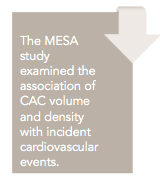Calcium Density of Coronary Artery Plaque and Risk of Incident Cardiovascular Events
The Multi-Ethnic Study of Atherosclerosis study examined the association of coronary artery calcium volume and density with incident cardiovascular events.

Siddharth Singh, MD, and Navin Nanda, MD
Review
JAMA
Criqui MH, Denenberg JO, Ix JH, et al.Calcium density of coronary artery plaque and risk of incident cardiovascular events.. 2014;311:271-278.

C
oronary artery calcium (CAC) scoring has been shown to improve risk prediction among those at intermediate risk of cardiovascular disease (CVD) and predict CVD-related outcomes. The Agatston score, which is a volume-based calcium score weighted upwards for calcium density, has been most commonly used in studies exploring the role of CAC.1 An increase in Agatston score can result from an increase in the volume of calcified plaque, its density, or both. Pathological and clinical studies have suggested that stable plaques tend to be more calcified, and interventions to promote plaque stability (like statins) may increase calcification (and reduce lipid core). In lieu of this, additional methods to measure CAC to guide risk prediction may be needed.
Study Details
Criqui et al examined the association of CAC volume and density with incident cardiovascular events in the prospective Multi-Ethnic Study of Atherosclerosis (MESA) cohort study.
Their analysis included data on 3398 men and women without known CVD at baseline, 45 to 84 years of age, at 6 centers across the United States. CAC was measured in scans performed using either electron beam or multi-detector CT systems. All participants had 2 serial scans (slice thickness varied from 2.5 mm to 3 mm) where Agatston score, volume score (total calcium volume in mm3), area score (calculated by dividing volume score by slice thickness), and calcium density score (calculated by dividing the Agatston score by area score) were measured. Participants were enrolled from 2000 to 2002 and follow-up was completed in 2008 to 2010 (median follow-up, 7.6 years).
2
End points examined included hard coronary heart disease (CHD) (myocardial infarction, resuscitated cardiac arrest, and death from CHD) and hard CVD (hard CHD, stroke, or stroke death). Logarithmic transformations of Agatston, volume, and density scores were performed because prior work showed log linear relationship between those variables and CVD risk. Agatston, area, and volume scores showed excellent Spearman’s correlation. The density score was only modestly correlated with other scores. In multivariable Cox proportional hazards regression models that adjusted for age, gender, and race/ethnicity, Agatston, area, and volume scores showed statistically significant associations with hard CHD and CVD events, with hazard ratios (HRs) ranging from 1.40 to 1.60. This persisted when the authors adjusted for Framingham risk score (FRS) and statin use. The density score was not associated with CHD and CVD events in any multivariable models.
P
P
The authors also examined multivariable models where both volume and density scores were included at the same step. In combined models, the HRs for volume score for CHD increased from 1.52 (95% confidence interval [CI], 1.29-1.80) to 1.81 (95% CI, 1.47-2.23); and from 1.38 (95% CI, 1.21-1.58) to 1.68 (95% CI, 1.42-1.98) for CVD events when the density score was included in the model. Interestingly, the density score became significantly and inversely associated with CHD (HR, 0.73; 95% CI, 0.58-0.91) and with CVD (HR, 0.71; 95% CI, 0.60-0.85). Hence, at any given volume score, higher density score was associated with decreased incidence of CVD and CHD events. Increasing quartiles of volume score and density score were respectively associated in a stepwise fashion with increasing and decreasing HRs for CHD and CVD events in multivariable models. The authors also analyzed the incremental value of adding calcium volume and density scores to risk prediction by examining the increase in the area under the receiver operating characteristic curve (AUC). For CHD events, the AUC for the base model was 0.67 (95% CI, 0.63-0.73), which increased to 0.70 (95% CI, 0.66-0.74; = .01) by adding the volume score, and to 0.71 (95% CI, 0.68-0.75; = .05) with addition of the density score. For CVD, the AUC for the base model was 0.67 (95% CI, 0.64-0.70), which increased to 0.69 (95% CI, 0.66-0.72; P = .01) by adding the vol- ume score, and to 0.70 (95% CI, 0.68-0.73; P = .02) by further addition of the density score.
The authors also examined change in AUC for CVD by FRS risk categories (low <1% per year, intermediate 1%-2% per year, and high ≥2% per year). In both low- and high-risk groups, addition of calcium density did not provide additional significant discrimination. However, in those at intermediate risk of CV events, the AUC for CVD events increased from 0.53 (95% CI, 0.48-0.59) to 0.59 (95% CI, 0.54-0.64; P = .017), with the addition of density score. A lower number of CHD events did not permit similar AUC analysis for CHD.
Although statin use was inversely associated with CVD and CHD events, results were not statistically significant.
The authors concluded that CAC volume was positively and independently associated with both CHD and CVD risk. At any level of CAC volume, density was inversely and significantly associated with CHD and CVD events.
CommentaryA Front-Runner Among New Kids on the Block?
T
he presence of CAC is highly sensitive for the presence of ≥50% angiographic stenosis, but has limited specificity, especially in older patients. However, the absence of CAC, particularly in asymptomatic patients, has an excellent negative predictive value. It appears that CAC is a better indicator of the extent of atherosclerosis than the severity of stenoses. Higher volume of coexistent vulnerable plaque may explain most of the CHD risk seen in patients with high CAC.
Criqui et al have shown that for the same volume of CAC, higher calcium density of plaques may protect against CVD events. Newer calcium metrics evaluated by Criqui et al should not require extra cost and may have better scaling characteristics, showing potential to replace the Agatston score. However, the limitations of their analysis in the current setting should be acknowledged. Beyond CAC, plaque density added only modestly to the AUC statistic and reclassification for those at intermediate risk of CV events. In those at intermediate risk who experienced CV events (113 of 1021), addition of density score led to net reclassification of only 4 individuals (3.5%). This suggests that more validation studies with density and volume scores may be needed. The authors also acknowledge that the density scale they used was somewhat “arbitrary” and not a perfectly continuous variable, with values >400 Hounsfield units being assigned a score of 4 (the scale was derived from Agatston score).
There are issues with advocating more widespread implementation of CAC scoring. CAC screening is unlikely to benefit those judged to be at high or low risk of CV events.3 At present, institution of pharmacotherapy for risk factor modification in asympto-
matic patients with CAC has not been shown to improve outcomes. The strategy sounds attractive, especially as a few studies have shown that knowledge of calcium scores may promote compliance with medical therapy and behavioral changes, although the data have been mixed.4 However, such a trial would be logistically difficult given the large sample size needed for such a study.5
CAC imaging and scoring appears to be the front-runner among newer “kids on the block” for CVD risk stratification. However, more data from cost-effectiveness analyses are needed to recommend widespread utilization for decision making in those at risk for CVD events.6
References
J Am Coll Cardiol
1. Agatston AS, Janowitz WR, Hildner FJ, et al. Quantification of coronary artery calcium using ultrafast computed tomography. . 1990;15:827-832.
JAMA
2. Criqui MH, Denenberg JO, Ix JH et al. Calcium density of coronary artery plaque and risk of incident cardiovascular events. . 2014;311:271-278.
J Am Coll Cardiol
3. Greenland P, Alpert JS, Beller G, et al. 2010 American College of Cardiology Foundation, American Heart Association guideline for assessment of cardiovascular risk in asymptomatic adults: a report of the ACCF/AHA Task Force on Practice Guidelines. . 2010;56(25):e50-e103.
Am J Cardiol
4. Orakzai RH, Nasir K, Orakzai SH, et al. Effect of patient visualization of coronary calcium by electron beam computed tomography on changes in beneficial lifestyle behaviors. . 2008;101(7):999-1002.
Curr Cardiol Rep
5. Youssef G, Kalia N, Darabian S, Budoff MJ. Coronary calcium: new insights, recent data, and clinical role. . 2013;15:325.
JAMA
6. Greenland P. More evidence for coronary calcium as a measure of cardiovascular risk: has anything changed? . 2014;311:247-248.
About the Author
S
iddharth
S
ingh
, MD,
N
avin
C. N
anda
, MD,
is an Assistant Professor of Cardiology at the University of Alabama at Birmingham. Dr Singh was assisted in the writing of this article by Distinguished Professor of Medicine and Cardiovascular Disease and Director of the Heart Station/Echocardiography Laboratories of the University of Alabama at Birmingham. Dr Nanda is also Director of the Echocardiography Laboratory at the Kirklin Clinic, University of Alabama Health Services Foundation. He has received many awards for service and achievement in medicine and is the author of numerous publications.
